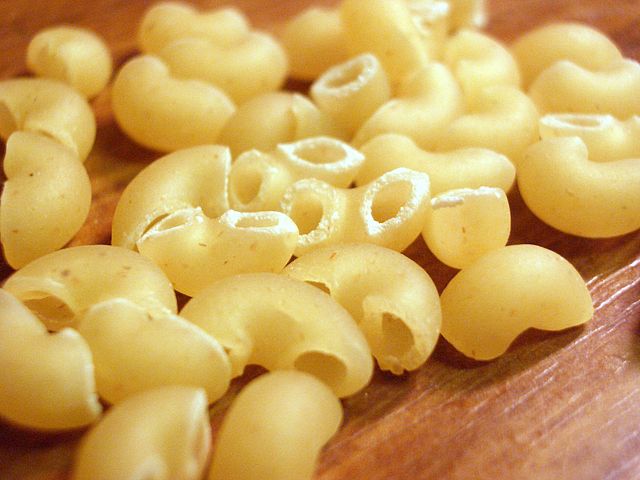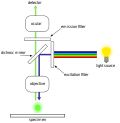Top Qs
Timeline
Chat
Perspective
Food physical chemistry
Branch of food chemistry From Wikipedia, the free encyclopedia
Remove ads
Remove ads
Food physical chemistry is considered to be a branch of Food chemistry[1][2] concerned with the study of both physical and chemical interactions in foods in terms of physical and chemical principles applied to food systems, as well as the applications of physical/chemical techniques and instrumentation for the study of foods.[3][4][5][6] This field encompasses the "physiochemical principles of the reactions and conversions that occur during the manufacture, handling, and storage of foods."[7]
Food physical chemistry concepts are often drawn from rheology, theories of transport phenomena, physical and chemical thermodynamics, chemical bonds and interaction forces, quantum mechanics and reaction kinetics, biopolymer science, colloidal interactions, nucleation, glass transitions, and freezing,[8][9] disordered/noncrystalline solids.
This section needs expansion with: actual complete English sentence containing relevance to food physical chemistry. You can help by adding to it. (January 2022) |
Techniques utilized range widely from dynamic rheometry, optical microscopy, electron microscopy, AFM, light scattering, X-ray diffraction/neutron diffraction,[10] to MRI, spectroscopy (NMR,[11] FT-NIR/IR, NIRS, ESR and EPR,[12][13] CD/VCD,[14] Fluorescence, FCS,[15][16][17][18][19] HPLC, GC-MS,[20][21] and other related analytical techniques.
Understanding food processes and the properties of foods requires a knowledge of physical chemistry and how it applies to specific foods and food processes. Food physical chemistry is essential for improving the quality of foods, their stability, and food product development. Because food science is a multi-disciplinary field, food physical chemistry is being developed through interactions with other areas of food chemistry and food science, such as food analytical chemistry, food process engineering/food processing, food and bioprocess technology, food extrusion, food quality control, food packaging, food biotechnology, and food microbiology.
Remove ads
Topics in Food physical chemistry
Summarize
Perspective
The following are examples of topics in food physical chemistry that are of interest to both the food industry and food science:


- Water in foods
- Local structure in liquid water
- Micro-crystallization in ice cream emulsions
- Dispersion and surface-adsorption processes in foods
- Water and protein activities
- Food hydration and shelf-life
- Hydrophobic interactions in foods
- Hydrogen bonding and ionic interactions in foods
- Disulfide bond breaking and formation in foods
- Food dispersions
- Structure-functionality in foods
- Food micro- and nano- structure
- Food gels and gelling mechanisms
- Cross-linking in foods
- Starch gelatinization and retrogradation
- Physico-chemical modification of carbohydrates
- Physico-chemical interactions in food formulations
- Freezing effects on foods and freeze concentration of liquids
- Glass transition in wheat gluten and wheat doughs
- Drying of foods and crops
- Rheology of wheat doughs, cheese and meat
- Rheology of extrusion processes
- Food enzyme kinetics
- Immobilized enzymes and cells
- Microencapsulation
- Carbohydrates structure and interactions with water and proteins
- Maillard browning reactions
- Lipids structures and interactions with water and food proteins
- Food proteins structure, hydration and functionality in foods
- Food protein denaturation
- Food enzymes and reaction mechanisms
- Vitamin interactions and preservation during food processing
- Interaction of salts and minerals with food proteins and water
- Color determinations and food grade coloring
- Flavors and sensorial perception of foods
- Properties of food additives
Remove ads
Related fields

- Food chemistry
- Food physics and Rheology
- Biophysical chemistry
- Physical chemistry
- Chemical physics
- Quantum chemistry
- Quantum genetics
- Molecular models of DNA and Molecular modelling of proteins and viruses
- Bioorganic chemistry
- Polymer chemistry
- Biochemistry and Biological chemistry
- Complex system biology
- Food technology, Food engineering, Food safety and Food biotechnology
- Agricultural biotechnology
- Immobilized cells and enzymes
- Microencapsulation of food additives and vitamins, etc.
- Agricultural biotechnology
- Chemical engineering
- Plant biology and Crop sciences
- Animal sciences
Remove ads
Techniques gallery: High-Field NMR, CARS (Raman spectroscopy), Fluorescence confocal microscopy and Hyperspectral imaging
- Stoks and anti-Stokes shifts
- CARS Raman Spectroscopy
- Hyperspectral Imaging Cube
- Multi-spectral Imaging principle
- Confocal Imaging Principle
- Fluorescence microscope
- Yeast membrane protein imaging
- Dividing cell fluorescence
- HeLa cancer cells
- FISH fluorescence technique
- Red blood cell pathology
- Carboxyzome
See also


- Food chemistry
- Biophysical chemistry
- Protein–protein interactions
- Food processing
- Food engineering
- Food rheology
- Food extrusion
- Food packaging,
- food biotechnology
- Food safety
- Food science
- Food technology
- International Academy of Quantum Molecular Science
- List of important publications in chemistry § Physical chemistry
- List of unsolved problems in chemistry § Physical chemistry problems
Remove ads
References
Journals
External links
Wikiwand - on
Seamless Wikipedia browsing. On steroids.
Remove ads
















